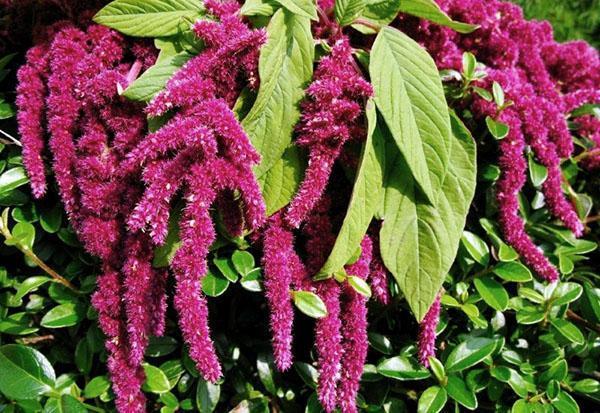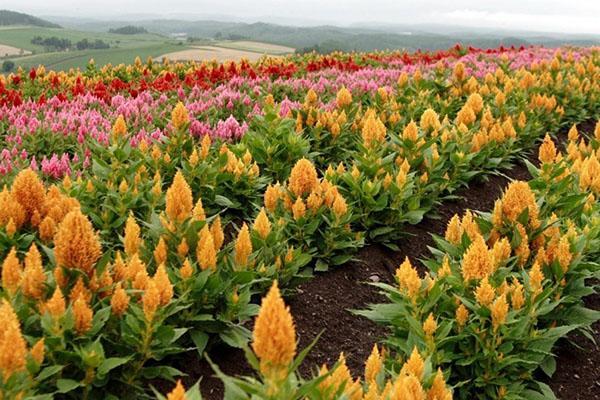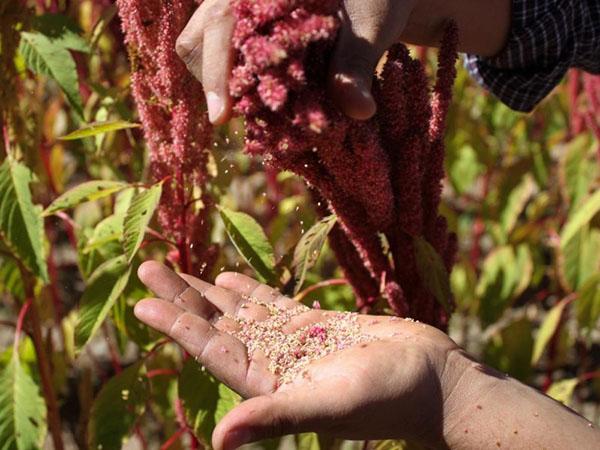Technology for growing amaranth from seeds and seedlings
 The technology for growing amaranth is quite simple. Due to its unpretentiousness, the plant is especially popular. This is a unique flower native to the lands of America. The culture has been cultivated for more than 8 thousand years. Many young leaves, flowers, and stems are eaten, sent to livestock feed and used as a medicinal plant. To grow a healthy and beautiful amaranth, you need to know when to plant it outdoors and how to care for it.
The technology for growing amaranth is quite simple. Due to its unpretentiousness, the plant is especially popular. This is a unique flower native to the lands of America. The culture has been cultivated for more than 8 thousand years. Many young leaves, flowers, and stems are eaten, sent to livestock feed and used as a medicinal plant. To grow a healthy and beautiful amaranth, you need to know when to plant it outdoors and how to care for it.
General rules for growing amaranth

When cultivating it, the following features of the plant should be taken into account:
- Amaranth is drought tolerant. It tolerates them much better than overfilling.
- Does not like excess moisture in the soil. Therefore, watering should be moderate. After each procedure, the soil between the rows must be loosened.
- To grow it, you should choose a well-lit place, since amaranth loves the sun very much.
- The optimal growing conditions are + 20 ° С, but the plant can easily tolerate small night frosts (not lower than -2 ° С).
- Little is affected by pests and diseases.
To grow amaranth in Siberia, you need to use ready-made seedlings.
In order for the culture to branch well and give a higher yield, it is necessary to systematically weed the garden bed and thin out the seedlings. Distance between stems up to 10 cm is preferable for forage specimens. A wider space (about 20 cm) is required for plants that are grown for seeds.
After the first month of growing season, the culture adds 6-7 cm per day. At this stage, there is no need to weed it, since the weeds do not compete with amaranth. But one should not forget about the introduction of organic or mineral fertilizers. It is necessary to feed the plantations every 10 days. It is better to do this in the morning, right after watering. Zeal with nitrogen fertilizers it is impossible, since nitrates will accumulate in the plant, as a result it will be unsuitable for food.
What seeds look like
 Many do not know what amaranth seeds look like. In fact, it is not difficult to distinguish the grains of this crop from other plants. Amaranth planting material is very small. Light varieties of plants with green leaves have sandy seeds (like white sesame, only much smaller), with dense, smooth, slightly shiny shells. Such varieties are used for food and feed purposes. Plants with red leaves are decorative varieties that are grown for beautiful flowers. They have black seeds, also very small. Before planting amaranth seeds, it is recommended for convenience to mix the grains with sawdust, wood ash or sand in a ratio of 1:20.
Many do not know what amaranth seeds look like. In fact, it is not difficult to distinguish the grains of this crop from other plants. Amaranth planting material is very small. Light varieties of plants with green leaves have sandy seeds (like white sesame, only much smaller), with dense, smooth, slightly shiny shells. Such varieties are used for food and feed purposes. Plants with red leaves are decorative varieties that are grown for beautiful flowers. They have black seeds, also very small. Before planting amaranth seeds, it is recommended for convenience to mix the grains with sawdust, wood ash or sand in a ratio of 1:20.
Seeds ripen well, being on inflorescences in a dark place.
The growing season of amaranth is 70 days, while the seeds are formed after 3 months of cultivation. The grains do not ripen at the same time, so it is easier to cut off whole amaranth inflorescences, otherwise some just fall on the ground.
When the panicles turn brown and dry well after about a month or two, you need to remove the seeds. It is necessary to dry them only in a dark place.
You can clean them simply in the wind or on a very fine sieve.When stored in a dry place, amaranth seeds retain the ability to germinate for five years.
Technology for growing amaranth from seeds
 In this way, cultivars oriented towards the accumulation of green mass are cultivated. Before growing amaranth from seeds, it is necessary to prepare beds for it in the fall. For this, the earth is dug to a depth of at least 20 cm, and also organic fertilizers... The best option is humus or compost. Each hundred square meters will need about 500 kg. The beds should be oriented north-south. It is impossible to sow amaranth on slopes, as even small streams from rain can wash its seeds. In the spring, the beds need to be dug up again and mineral fertilizing applied. Amaranth is sown in rows, and then thinned out.
In this way, cultivars oriented towards the accumulation of green mass are cultivated. Before growing amaranth from seeds, it is necessary to prepare beds for it in the fall. For this, the earth is dug to a depth of at least 20 cm, and also organic fertilizers... The best option is humus or compost. Each hundred square meters will need about 500 kg. The beds should be oriented north-south. It is impossible to sow amaranth on slopes, as even small streams from rain can wash its seeds. In the spring, the beds need to be dug up again and mineral fertilizing applied. Amaranth is sown in rows, and then thinned out.
For the grains to grow well, it is important to choose the right planting time for the plant. The soil should have time to warm up to positive values. This is usually the end of May. The depth of the holes should be about 5 cm. In such conditions, the seeds will sprout well, and the culture will grow so quickly that it will easily overtake the weeds and they will not be able to drown out the amaranth. You don't even have to weed it.
If you skip the optimal period and sow later, you will have to deal with weeds, as well as pests: aphids, weevils, caterpillars. In a flower bed or in a small garden, amaranth is sown by hand. In large fields, sowing is carried out using special seeders. The soil should be moist and nutritious. Also, in order for amaranth to develop well in the open field, in addition to care, planting rules must be followed.
 The distance between the rows should be:
The distance between the rows should be:
- 70 cm when growing amaranth for seeds;
- 50 cm when cultivating a plant for forage purposes.
The first shoots break through the ground after a week or 10 days. At first, amaranth grows slowly, but then noticeably accelerates. You can re-sow after 2 weeks so that the period of formation of young greenery is as long as possible.
In Siberia, ordinary plant varieties from seeds can be grown only for green mass, since they do not have time to form new grains. In this climatic zone, it is better to cultivate early ripening varieties of amaranth, for example, Cherginsky. And also plant seedlings of plants in open ground.
Growing amaranth seedlings
 Cultivating a plant from seed is the easiest way. But to accelerate the ripening period of amaranth, which is about 3 months, it is better to grow it using seedlings. This method guarantees a more lush flowering, therefore this method is also practiced for decorative varieties.
Cultivating a plant from seed is the easiest way. But to accelerate the ripening period of amaranth, which is about 3 months, it is better to grow it using seedlings. This method guarantees a more lush flowering, therefore this method is also practiced for decorative varieties.
Before germinating amaranth at home, you need to remember that the grains should be sown in a container at the end of February or in March.
In order to grow amaranth for seedlings, you must:
- In early spring, sow the seeds in prepared soil, preferably in peat containers. The soil should be loose, the seeds should be sprinkled with earth only a little and not tamped.
- The pots must be placed in a greenhouse from a plastic container or covered with foil.
- Systematically ventilate the mini-greenhouse and water the ground.
- When the seeds sprout, they need to be thinned out.

- As the seedlings grow, they are periodically taken out to fresh air so that they get used to new conditions (hardened).

Another option for obtaining seedlings is to sow seeds in a box with soil and place it in a plastic bag, put in a warm place. After one to two weeks, seedlings appear and the plants can already be kept on the windowsill.
A few tips on how to germinate amaranth at home:
- In order for amaranth seeds to sprout better in an apartment or house, they must first be soaked in water for several days so that they "hatch".
- The soil is best prepared from a mixture of peat, leaf humus and soil from the garden. It is important to add ash and superphosphate to the mixture.
- Until sprouts appear, it is necessary to maintain the temperature at least + 20 ° C.
- Watering should be moderate but regular. You can carry it out with a spray bottle.
You cannot plant seedlings at lunchtime, when it is very hot outside.
If the first three or four leaves have appeared on the seedlings, this means that it is time to dive amaranth. To do this, you need to take pots with a diameter of about 12 cm and plant the plants so that there is only one copy in each of them.
Planting amaranth and care in the open field
 You can plant seedlings in open ground in about a month after germination. The best month is May, when the danger of frost is gone. The average daily temperature must be at least + 5 ° C. The procedure should be carried out in cloudy weather. Planting a flower in the evening is also good.
You can plant seedlings in open ground in about a month after germination. The best month is May, when the danger of frost is gone. The average daily temperature must be at least + 5 ° C. The procedure should be carried out in cloudy weather. Planting a flower in the evening is also good.
The culture thrives on a variety of soils. Including on sandy and rocky soils, even on salt marshes.
Transplant stages:
- To begin with, the grown amaranth seedlings are well watered.
- Two or three plants are planted in each hole.
- After planting, the stems are sprinkled to the first leaf.
- Water abundantly.
Caring for amaranth obtained from seeds or seedlings is no different. At the beginning, it is weeded, and then only watered and fed. For better branching, you can pinch the top of the plant at the end of June. It is good to periodically huddle the culture, and tie up the tallest specimens. If not, they can break due to their heavy panicle flowers.
When the plant reaches a height of 20-25 centimeters, it can be cut for greenery. After a short time, the stems will give new shoots. After harvesting, the rest of the plant is best placed in a compost pit for excellent fertilization for the next season.
As you can see from the article, planting and caring for the amaranth plant is very simple. To grow a beautiful flower, it is enough to follow the basic rules.